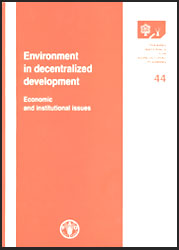 Prepared
by
Prepared
byVito Cistulli
Agricultural Policy Support Service
Policy Assistance Division
 Prepared
by
Prepared
by
Vito Cistulli
Agricultural Policy Support Service
Policy Assistance Division
Food and Agriculture Organization of the United Nations
Rome, 2002
TRAINING MATERIALS FOR AGRICULTURAL PLANNING
44
|
The designations employed and the presentation of material in this publication do not imply the expression of any opinion whatsoever on the part of the Food and Agriculture Organization of the United Nations concerning the legal status of any country, territory, city or area or of its authorities, or concerning the delimitation of its frontiers or boundaries. |
ISBN 92-5-104836-3
All rights reserved. Reproduction and dissemination of material in this information product for educational or other non-commercial purposes are authorized without any prior written permission from the copyright holders provided the source is fully acknowledged. Reproduction of material in this information product for resale or other commercial purposes is prohibited without written permission of the copyright holders. Applications for such permission should be addressed to the Chief, Publishing Management Service, Information Division, FAO, Viale delle Terme di Caracalla, 00100 Rome, Italy or by e-mail to [email protected]
© FAO 2002
Chapter 1. Why caring for the environment
1.1 Summary
1.2 Defining environmental issues
1.3 Environment provides the resource base for life support
1.4 Environmental resources are scarce
1.5 Misestimation of environmental values can impair economic growth
1.6 The sustainable development motive
Appendix 1.1 Economic analysis of efficient provision of common pool goods
Appendix 1.2 Pricing of natural resources taking account of future generations (Marginal User Cost Concept)
Chapter 2. Decentralization and environmental issues
2.1 Summary
2.2 Definition and concept of decentralization
2.3 Forms of decentralization
2.4 Some good reasons for decentralization
2.5 Possible constraints to decentralization
2.6 Resolution of environmental problems at the farm/household level
2.7 Resolution of externalities through negotiations among parties
2.8 Resolution of environmental externalities with spillover effects outside the area
2.9 Some rules for choosing the most suitable institution/organization to cope with environmental problems
2.10 Basic conditions for successful decentralization
Chapter 3. Fostering environment in decentralized decision-making
3.1 Summary
3.2 The role of government
3.3 A framework for environmental considerations in decentralized decision-making
Chapter 4. Entry points of environment in decision-making at local government level
4.1 Summary
4.2 Natural resources assessment
4.3 Analysis of problems and objective setting
4.4 Action planning
4.5 Monitoring and Evaluation (M&E)
Annex 1. Economic and regulatory instruments
Annex 2. Monetary valuation of environmental goods and services
Annex 3. Participatory Rural Appraisal (PRA)
Annex 4. Xichang Training Case Study on Environmental and Natural Resources Analysis. Selected Analytical Tools - (Excerpt)Analytical Framework
Planning Theme and Utility
Choice and Application of Analytical Tools
Exhibit 1. Summary of Contextual Information on Xichang
Exhibit 2. Local Government Environmental Responsibilities for Management of Qionghai Lake and Measures Taken Todate
Exhibit 3. Checklist of Bio-physical and Socio-economic Information Items to be Collected on Xichang City
Analytical ResultsTable 1. Natural Resource Inventory and Hazards, Xichang City: Summary
Table 2a. Resource Depletability Analysis, Selected Examples from Xichang
Table 2b. Resource Suitability Analysis (Selected Examples)
Table 3. Resource Use and Stakeholder Analysis, Qionghai Lake
Table 4a. Socio-economic Circumstances of Local Communities: Upstream and Downstream Villages
Table 4b. Historical Timelines for two Communities in Erjang Subwatershed*
Table 5. Pressure-State - Response Framework: Examples from Qionghao Lake
Table 6a. Conflict-Complementarity Matrix, Qionghai Lake
Table 6b. Possible Outline for Policy Tradeoff Matrix, Qionghai Lake
Table 7a. Resource-Influence. Analysis of Qionghai Lake and Related Subwatersheds, Primary Stakeholders
Table 7b. Resource-Power-Influence. Analysis of Qionghai Lake and Related Subwatersheds, Secondary Stakeholders
Table 8. SWOT Analysis, Qionghai Lake Management Bureau